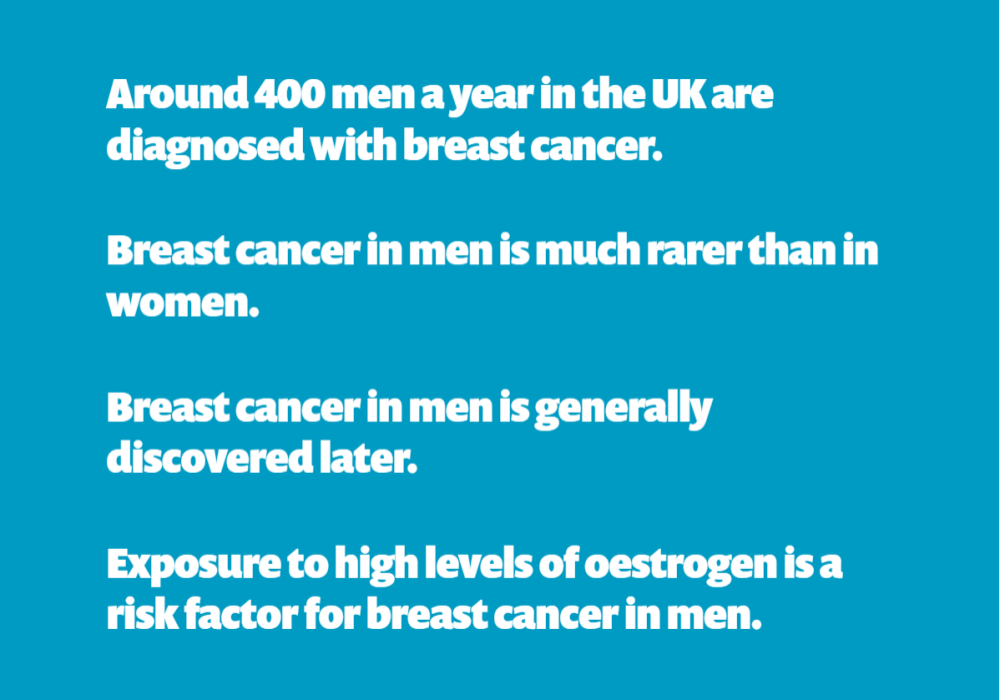News
Around 400 men a year in the UK are diagnosed with breast cancer

Breast cancer in men is often discovered later, so it is vital that more men become aware of the causes and signs of breast cancer and what they can do to reduce their risk of getting this devastating disease.
What does breast cancer in men look like?
Let’s start off with the simplest, but probably most important thing you’ll need to know. Men can get breast cancer. Most UK patients are diagnosed between the ages of 60-70, which is on average 5-10 years later than the age of diagnosis in women. The incidence of male breast cancer has remained stable in the UK for most age groups for the past 20 years, however, it has increased in the 65-69 age group by around 38%.
The symptoms of breast cancer in men include:
- A breast lump that is typically firm, painless, and immobile within the breast.
- Nipple inversion or inward turning.
- Nipple discharge, which may contain streaks of blood.
- Persistent soreness or rash around the nipple.
- Hardening, redness, or swelling of the nipple or surrounding skin.
- Presence of small swollen bumps in the armpit (enlarged glands).
Why isn’t breast cancer as common in men?
While research into female breast cancer continues at a steady rate, male breast cancer research remains significantly underfunded.
Breast cancer in men is much rarer than in women, mainly because men have less breast tissue and lower lifetime oestrogen exposure. Elevated lifetime exposure to oestrogen is a well-established breast cancer risk factor. However, this does not mean that men are in the all-clear.
Does the type of breast cancer differ between males and females?
The most common type of breast cancer in men and women is ‘invasive breast cancer of no special type’ meaning when the cancer is viewed under the microscope it has no special features. Over 90% of breast cancers in men are diagnosed as this type, compared to around 70% for women.
Other types of breast cancer in men include ductal carcinoma in situ, invasive lobular carcinoma, and Paget’s disease of the breast, however these are extremely rare.
Breast cancers are also categorised by the presence of hormone receptors (namely oestrogen and progesterone). Around 91-95% of breast cancers in men are positive for oestrogen receptors, meanwhile in women this number is around 75%.
As in female breast cancer, genetics and family history play a role in breast cancer risk, including mutations in the BRCA2 gene and a strong family history of the disease (having a first degree relative with breast cancer).
For more information on the types of breast cancer and hormone receptors, please visit Breast Cancer UK's biology of breast cancer page.
What increases your risk?
- Weight: Being overweight or obese
- Diet: A poor diet, high in processed food, and alcohol consumption and low in fruit and vegetables
- Exercise: Lack of physical activity
- Chemical Exposure: Long-term exposure to harmful chemicals such as carcinogens (cancer-causing chemicals) or endocrine disrupting chemicals (EDCs).
- Occupational exposures – Studies suggest certain occupations may carry a higher risk of breast cancer in men due to long-term exposure to carcinogens and EDCs. These include motor mechanics, power workers exposed to electromagnetic radiation and steel and furnace workers.
- Genetics plays an important role in breast cancer in men. Around 20% of men with breast cancer have a close relative (parent, sibling or child) with the disease. Around 10% of men with breast cancer have the BRCA2 breast cancer susceptibility gene. Around 1-2% of men with breast cancer carry the BRCA1 gene. Both types of BRCA mutations also increase susceptibility to prostate cancer.
Hormones and breast cancer in men
As for female breast cancer, exposure to high levels of oestrogens is a significant risk factor for breast cancer in men. Importantly it is the ratio of male hormones such as testosterone to oestrogens that is important for healthy breast tissue. Various factors may affect hormone levels, including:
- Inherited genetic conditions, especially Klinefelter’s syndrome – where men are born with an extra X chromosome; those with this condition account for around 7% of breast cancers in men.
- Synthetic hormones associated with male-to-female gender reassignment.
- Excess fat.
- Liver damage.
- Inflammation or damage to testes.
- Age is the most significant risk factor for breast cancer in men. Most UK men are diagnosed between the ages of 60-70.
- Radiation exposure due to medical treatment, especially at an early age, increases breast cancer risk in men.
- Studies found male infertility was associated with an increased risk of breast cancer in men (although the reasons for this are unclear).
For more details and references, please visit Breast Cancer UK's breast cancer in men background brief page or Breast cancer in men | Breast Cancer UK!
